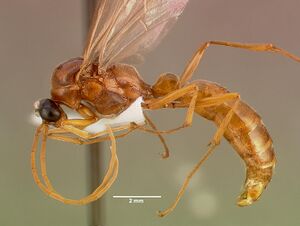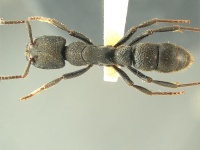Bothroponera granosa
| Bothroponera granosa | |
|---|---|

| |
| Scientific classification | |
| Kingdom: | Animalia |
| Phylum: | Arthropoda |
| Class: | Insecta |
| Order: | Hymenoptera |
| Family: | Formicidae |
| Subfamily: | Ponerinae |
| Tribe: | Ponerini |
| Genus: | Bothroponera |
| Species group: | pumicosa |
| Species: | B. granosa |
| Binomial name | |
| Bothroponera granosa (Roger, 1860) | |
Bothroponera granosa inhabits the grassy grove areas of West Grahamstown in South Africa, under stones. It can also be found in rocky habitats such as the area north west of Cathcart City in South Africa. (Joma and Mackay 2015)
Identification
Joma and Mackay (2015) - A member of the Bothroponera pumicosa species complex. The head of the worker is large and subquadrate. The mandibles are covered with hairs and partially by fine weakly defined striae and scattered coarse punctures. The anterior medial margin of the clypeus is “v” shaped with a raised sharp medial longitudinal carina. The scape reaches the posterior lateral corner of the head. The lower margin of the pronotum is straight with a strongly rounded angle at the anteroinferior pronotal process (lateral view), rounded inferior pronotal process and sometimes forming a sharp angle that is pointed posteroventrally. The petiole (dorsal view) is rounded and slightly narrowed anteriorly while it has a slight concavity on the upper medial margin between the two posterior angles of the petiolar apex. The posterior edge of the petiole is vertical (side or top view) and slightly concave (dorsal view). The sternopetiolar process is developed with a single tooth pointed ventrally.
The worker of B. granosa can be recognized by the anterior medial raised area of the clypeus (“v” shaped anterior border) that forms a sharp longitudinal carina, which differs from most of the other Bothroponera pumicosa species complex members (except Bothroponera cariosa and Bothroponera strigulosa). The anterior medial area of the clypeus is also “v” shaped in Bothroponera cavernosa, Bothroponera montivaga, Bothroponera aspera and Bothroponera umgodikulula, but without a carina in B. aspera and B. umgodikulula while it is partially carinate in B. cavernosa and B. montivaga. The other species, including B. cariosa, B. strigulosa, B. pumicosa, B. laevissima and B. berthoudi have an anterior medial raised area of the clypeus with a “u” shaped anterior border, however B. cariosa and B. strigulosa have a sharp carinae similar to B. granosa. The surface of B. granosa is more likely to be rough with moderately scattered punctures than that of the other B. pumicosa species complex taxa, which are always coarsely foveolate except for B. aspera and B. laevissima, which are shiny black with punctate sculpture. The petiolar shape of B. granosa is unique among the B. pumicosa species complex individuals even if the petiolar indices seem not to be separable. The petiole is rounded and slightly narrowed anteriorly (dorsal view) in all species of the B. pumicosa species complex including B. granosa, but the posterior face is deeply depressed from the upper edge to form two rounded apices found only in B. granosa (best seen from above). The petiolar indices vary among the B. pumicosa species complex members in that the smallest PetI recorded were for B. aspera (104.54 - 118.18), and B. berthoudi (105.55), whereas the largest PetI registered was for B. montivaga (130.00). The other species have intermediate PetI, B. umgodikulula (115 - 126), B. granosa (117 - 123), B. strigulosa (117.39), B. laevissima (118.18 - 121.05), B. pumicosa (120.00 - 125.00), B. cariosa (104 - 116), and B. cavernosa (126.08).
Keys including this Species
Distribution
Latitudinal Distribution Pattern
Latitudinal Range: -29.2375° to -34.125°.
| North Temperate |
North Subtropical |
Tropical | South Subtropical |
South Temperate |
- Source: AntMaps
Distribution based on Regional Taxon Lists
Afrotropical Region: South Africa (type locality), Zimbabwe, Zimbabwe, Zimbabwe.
Distribution based on AntMaps
Distribution based on AntWeb specimens
Check data from AntWeb
Countries Occupied
| Number of countries occupied by this species based on AntWiki Regional Taxon Lists. In general, fewer countries occupied indicates a narrower range, while more countries indicates a more widespread species. |

|
Estimated Abundance
| Relative abundance based on number of AntMaps records per species (this species within the purple bar). Fewer records (to the left) indicates a less abundant/encountered species while more records (to the right) indicates more abundant/encountered species. |

|
Biology
Castes
Worker
   
| |
| . | |
Male
   
| |
| . | |
Nomenclature
The following information is derived from Barry Bolton's Online Catalogue of the Ants of the World.
- granosa. Ponera granosa Roger, 1860: 290 (w.) SOUTH AFRICA.
- Type-material: holotype worker.
- Type-locality: South Africa: Cape of Good Hope (Drège).
- Type-depository: ZMUC.
- [Note: Roger, 1860: 291, says the specimen is deposited in H. Drewsen’s collection, ZMUC (Horn & Kahle, 1935: 61).]
- Arnold, 1926: 201 (m.).
- Combination in Pachycondyla (Bothroponera): Emery, 1901a: 45;
- combination in Pachycondyla: Arnold, 1926: 201; Brown, in Bolton, 1995b: 305;
- combination in Bothroponera: Mayr, 1862: 717; Roger, 1863b: 16; Wheeler, W.M. 1922a: 72; Joma & Mackay, 2013: 3; Schmidt, C.A. & Shattuck, 2014: 76.
- Status as species: Roger, 1863b: 16; Mayr, 1863: 397; Dalla Torre, 1893: 36; Forel, 1901f: 344; Emery, 1911d: 76; Forel, 1914d: 214; Arnold, 1915: 61; Wheeler, W.M. 1922a: 72 (in key), 770; Arnold, 1926: 201; Arnold, 1952a: 462 (in key); Bolton, 1995b: 305; Joma & Mackay, 2015: 551 (redescription).
- Distribution: South Africa, Zimbabwe.
Unless otherwise noted the text for the remainder of this section is reported from the publication that includes the original description.
Description
Worker
Joma and Mackay (2015) - (n= 20), HL 2.90 - 3.10, HW 2.40 - 2.75, ML 1.40 - 1.75, EW 0.30 - 0.40, EL 0.40 - 0.50, SL 1.90 - 2.35, FL 2.90 - 3.50, WL 3.90 - 4.45, WPL 4.80 - 5.40, PL 1.20 - 1.30, PW 1.40 - 1.60, PH 1.50 - 1.80, CI 83 - 89, OI 17 - 18.18, MandI 48.27 - 56.45, SI 79.16 - 85.45, PetI 117 – 123. Total length 13.75 - 14.50 mm; mandibles with 7 teeth; clypeal length 1.70 - 2.35 mm; malar space length from lower edge of eye to base of mandible 0.40 - 0.65 mm; from upper edge of eye to edge of posterior lobe 1.35 - 1.70 mm; frontal lobe width 0.90 - 1.15 mm; metapleuron rough and weakly punctate; head covered with small dense punctures; sides of head covered with fine striae; dorsum of pronotum, mesonotum, mesopleuron, lateropropodeum and propodeum moderately punctate, moderately shiny; metapleuron rough, weakly punctate; petiole covered with deeper sparse punctures and foveolae than postpetiole; postpetiole covered with shallow sparse punctures, foveolate, with weakly defined fine striae; dorsum of second gastral segment covered with shallow foveolae and striae; remaining gastral segments shiny; lower margin of pronotum straight with strong angle at anteroinferior pronotal process, rounded inferior pronotal process; antennae, legs, lower edge of frontal lobes, mandibles shiny; entire surface of B. granosa worker covered with fine short (up to 0.15 mm) silver hairs, denser on second - seventh gastral segments (up to 0.20 mm); entire surface covered with scattered erect golden hairs, including mandibles, scapes; head, pronotum, mesonotum; propodeum covered with short erect golden hairs (0.10 - 0.15 mm); dorsum of petiole covered with short erect golden hairs (0.15 mm); postpetiole, entire gaster covered with longer erect golden hairs (0.15 - 0.20 mm); hairs on sternum of postpetiole, hairs on other gastral segments reach about 0.30 mm.
Head, pronotum, mesonotum, mesopleuron, propodeum, petiole, postpetiole, entire gaster black; legs, antennae, clypeus, mandibles brownish black.
References
- Arnold, G. 1926. A monograph of the Formicidae of South Africa. Appendix. Ann. S. Afr. Mus. 23: 191-295 (page 201, male described)
- Brown, W. L., Jr. 1995a. [Untitled. Taxonomic changes in Pachycondyla attributed to Brown.] Pp. 302-311 in: Bolton, B. A new general catalogue of the ants of the world. Cambridge, Mass.: Harvard University Press, 504 pp. (page 305, Combination in Pachycondyla)
- Emery, C. 1901b. Notes sur les sous-familles des Dorylines et Ponérines (Famille des Formicides). Ann. Soc. Entomol. Belg. 45: 32-54 (page 45, Combination in Pachycondyla (Bothroponera))
- Esteves, F.A., Fisher, B.L. 2021. Corrieopone nouragues gen. nov., sp. nov., a new Ponerinae from French Guiana (Hymenoptera, Formicidae). ZooKeys 1074, 83–173 (doi:10.3897/zookeys.1074.75551).
- Joma, A.M.A. & Mackay, W.P. 2015. Revision of the African ants of the Bothroponera pumicosa species complex (Hymenoptera: Formicidae: Ponerinae). Sociobiology 62: 538-563 (doi:10.13102/sociobiology.v62i4.845).
- Joma, A.M.A., Mackay, W.P. 2020. Revision of the African ants of the Bothroponera talpa species complex (Hymenoptera: Formicidae: Ponerinae). Transactions of the American Entomological Society 146: 355-408. (doi:10.3157/061.146.0206).
- Mayr, G. 1862. Myrmecologische Studien. Verh. K-K. Zool.-Bot. Ges. Wien 12: 649-776 (page 717, Combination in Bothroponera)
- Roger, J. 1860. Die Ponera-artigen Ameisen. Berl. Entomol. Z. 4: 278-312 (page 290, worker described)
- Schmidt, C.A. & Shattuck, S.O. 2014. The higher classification of the ant subfamily Ponerinae (Hymenoptera: Formicidae), with a review of ponerine ecology and behavior. Zootaxa 3817, 1–242 (doi:10.11646/zootaxa.3817.1.1).
- Wheeler, W. M. 1922b. Ants of the American Museum Congo expedition. A contribution to the myrmecology of Africa. II. The ants collected by the American Museum Congo Expedition. Bull. Am. Mus. Nat. Hist. 45: 39-269 (page 72, Combination in Bothroponera)
References based on Global Ant Biodiversity Informatics
- Arnold G. 1926. A monograph of the Formicidae of South Africa. Appendix. Annals of the South African Museum. 23: 191-295.
- Emery C. 1911. Hymenoptera. Fam. Formicidae. Subfam. Ponerinae. Genera Insectorum 118: 1-125.
- Kotze D. J., and M. J. Samways. Invertebrate conservation at the interface between the grassland matrix and natural Afromontane forest fragments. 1999. Biodiversity and Conservation 8: 1339-1363.

